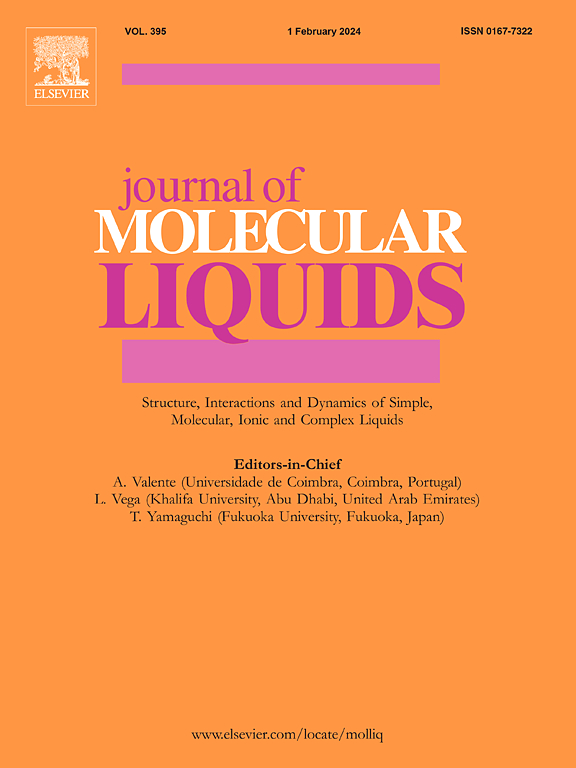Intermolecular interactions of BODIPY and SWCNTs in solutions, a new approach to obtaining in a supercritical CO2 the PMMA/BODIPY/SWCNTs composites
IF 5.3
2区 化学
Q2 CHEMISTRY, PHYSICAL
引用次数: 0
Abstract
In the field of materials science, the preparation of new luminescent composite materials based on a mixture of various photoactive compounds with an extended absorption and fluorescence range from the visible to the infrared region is of particular interest. The range of applications for multicomponent photoactive composites is rapidly expanding, including light-harvesting devices and laser limiters. Accordingly, it remains essential to develop polymer dyeing technology that preserves the practically significant properties of the components while eliminating the use of toxic organic solvents and high temperatures.
We have created new polymer composites (PMMA/BODIPY/SWCNTs) based on poly(methyl methacrylate) (PMMA) and photoactive compounds of various natures: boron(III) dipyrromethenate (BODIPY) luminophores and semiconductor single-walled carbon nanotubes (SWCNTs), which have absorption and fluorescence ranges in the visible (green) and infrared regions of light, respectively. The concept of dispersing mixtures of BODIPY and SWCNTs in a PMMA polymer within a supercritical fluid environment was successfully demonstrated. In addition, at the first step, we analyzed the spectral properties of BODIPY solutions in the presence of various amounts of SWCNT suspensions (s-SWCNT) in ethanol (with the addition of cholic acid (CA) as a dispersing agent) and dimethylacetamide (DMAA).
Using computer simulation, we conducted an analysis of the possible influence of structural factors and intermolecular interactions between BODIPYs and SWCNTs on the optical properties of luminophores in solutions. The computer simulation indicated that non-covalent BODIPY·SWCNT structures form, exhibiting numerous electronic transitions and electron density redistribution within the nanotube (from one part to another) and between BODIPY and SWCNT within the supramolecular complex.
It has been experimentally established that BODIPY dyes demonstrate significant spectral properties both in ethanol solutions and in polymer composites containing SWCNTs. Initial results indicate that sc-CO2 solutions present an attractive possibility for immobilizing BODIPY/SWCNT mixtures into polymers, providing unique combinations of spectral characteristics. Thus, the proposed method is an effective way to develop new composites based on a mixture of photoactive compounds with an extended working spectral range from the visible to the infrared spectrum for various optical devices.

求助全文
约1分钟内获得全文
求助全文
来源期刊

Journal of Molecular Liquids
化学-物理:原子、分子和化学物理
CiteScore
10.30
自引率
16.70%
发文量
2597
审稿时长
78 days
期刊介绍:
The journal includes papers in the following areas:
– Simple organic liquids and mixtures
– Ionic liquids
– Surfactant solutions (including micelles and vesicles) and liquid interfaces
– Colloidal solutions and nanoparticles
– Thermotropic and lyotropic liquid crystals
– Ferrofluids
– Water, aqueous solutions and other hydrogen-bonded liquids
– Lubricants, polymer solutions and melts
– Molten metals and salts
– Phase transitions and critical phenomena in liquids and confined fluids
– Self assembly in complex liquids.– Biomolecules in solution
The emphasis is on the molecular (or microscopic) understanding of particular liquids or liquid systems, especially concerning structure, dynamics and intermolecular forces. The experimental techniques used may include:
– Conventional spectroscopy (mid-IR and far-IR, Raman, NMR, etc.)
– Non-linear optics and time resolved spectroscopy (psec, fsec, asec, ISRS, etc.)
– Light scattering (Rayleigh, Brillouin, PCS, etc.)
– Dielectric relaxation
– X-ray and neutron scattering and diffraction.
Experimental studies, computer simulations (MD or MC) and analytical theory will be considered for publication; papers just reporting experimental results that do not contribute to the understanding of the fundamentals of molecular and ionic liquids will not be accepted. Only papers of a non-routine nature and advancing the field will be considered for publication.
 求助内容:
求助内容: 应助结果提醒方式:
应助结果提醒方式:


